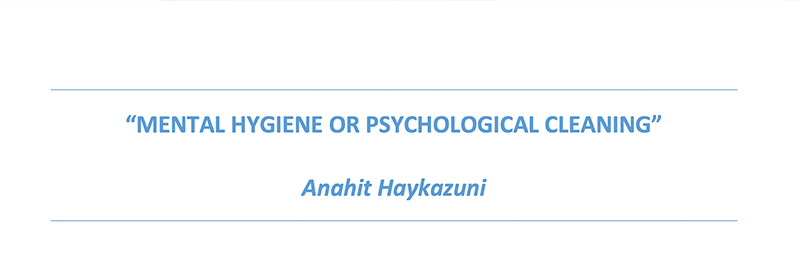Anahit Haykazuni ist eine Psyhologin aus Armenien und arbeitet mit Menschen, die direkt oder indirekt vom Krieg in Arzach (Berg-Karabach) betroffen wurden. Ihr Artikel ist ein Ergebnis der Teilnahme an internationaler Weiterbildung „Traumatherapie durch Mediation in Konflikt- und Postkonfliktregionen“, die im Dezember 2021 online und vor Ort in Armenien (Aghveran) von aritas-Armenia und European Ways e.V. (Leipzig) durchgeführt wurde. Unter anderem wurden Mechanismen entwickelt, um sich als Traumatherapeut_in vor einem Burnout zu schützen, und um andererseits weiterhin den vielen Betroffenen strukturiert helfen zu können. Die empfindlichen Reaktionen der lokalen Fachkräfte in diesem Aufarbeitungsprozess zeigten exemplarisch, wie wichtig es ist, solche Themen auch für die Armenier_innen in Westeuropa zu thematisieren und weiterhin Unterstützung von außen zu leisten. Das Projekt wurde vom Auswärtigen Amt Deutschlands finanziert.
A “Trauma Therapy in (Post) Conflict Regions” project organized by European Ways and implemented by Armenian Caritas in support of psychologists and allied professionals unwittingly led the participants of the training to such important topics as self-regulation and self-reflection, as well as adherence to the rules of mental hygiene.
“Above all else, guard your heart, for everything you do flows from it”
Proverbs 4:23
The room in which a person lives says a lot about him. You can understand the essence of a person by the interior that he has chosen, by the style and mechanism of arranging furniture and other attributes, by the color schemes that reign in this room. Looking in the closets you will definitely find some kind of mechanism by which things are sorted, and even the absence of this mechanism will give some information about this person.
Everything, of course, is not as banal as it might seem, since bright walls don’t always indicate the presence of some kind of character and can only indicate a desire to have such a character. Also, a meticulously sorted closet doesn’t at all indicate a person’s obsessive-compulsive tendency or a great love for order, it can serve as a sign of acceptance of reality as it is, or of sincerity. As you can see, everything is relative. Therefore, it is desirable to analyse everything together, and not in fragments, it is the only way to get reliable information.
This brings the question, who do we so diligently want to get information about? We will not invade other people’s rooms and explore them, trying to expose them as having some kind of negative character trait? This article is not about forensic psychological examination. In a sense, it is about self-knowledge, and this means that we should conduct research, first of all, not in other people’s, but in our own rooms.
The study of your room will provide information not only about the character and personality traits, but more importantly, about the current psychological state. That is, depending on how a person feels emotionally, what feeling dominates him now, how he reacts to certain incidents or to reality, this is how his room and even appearance will look like. It’s some kind of indicator. But here again, not everything is as banal as it seems. Many of us, knowing the before-mentioned phenomenon, tend to quickly tidy up our room, appearance. But what about your inner “room”? There is no such person who feels comfortable in a scattered room where everything is out of place. There are people who are so accustomed to this state that, feeling discomfort, they cannot determine what it is from, while others, knowing about the scattered state, want to put everything in its place, but understanding the complexity of it all, they are frustrated to the end and leave the room the way it is.
The same thing goes on in our heads. Our head is a kind of “room”, which we either always keep clean and in good condition, or we throw it to capacity, or sometimes put some order in, and then throw it again. These two rooms differ from each other only in a way that in our real room we see the scattered state in reality, it is felt materially, while all the information about the “room” of our head is rather abstract, we do not see them materially, or rather we see only in such categorically negative forms as depression, anxiety, phobia, excessive aggressiveness. This is also visible when we resort to the help of a alcohol, procrastinate, conflict a lot, become suspicious, look for provocations, provoke, manipulate, or become victims ourselves via deceit and manipulation by others. That is, until all these moments, we don’t see the mess in the “room” of our head, we ignore it. And even after all these before-mentioned phenomena, we don’t even suspect that the reason lies in the fact that we have not done cleaning in this “room” for a long time. As if in a real room the shirts were scattered in different corners, and one was even on the desk, some of the books were lying on the bed in a half-open or open state, the cup was on the floor, the headphones were lying in the closet, and the pen was under carpet. Imagine the same thing, only in your head. If a real room needs to be cleaned, then in the “room” of our head it would be appropriate to arrange psychological cleaning, that is, psychohygienic measures.
Mental hygiene is a branch of hygiene, as well as medical psychology, which is aimed at maintaining and achieving mental and psychological health. A mentally healthy person is a person who more or less realizes his basic healthy physiological needs, has a normalized sleep schedule, develops spiritually, has regular rest for at least a few minutes per hour, engages in physical activity, and organizes his social activity.
All this is important, but this is just the ground that we are preparing for more serious, one might say deep psychohygienic measures. Returning to the real room and real closets, we understand that cleaning begins with the distribution of things in their places, we pull shirts out of the whole mess and hang them in their places, find the scattered trousers and put them all together, separating some for washing. We put books, notebooks, pens and a laptop on the desk, we carry the dishes to the kitchen, we put headphones, combs, a hairdryer, flash drives and all other little things in their places, it remains only to wipe the dust and the room is ready for adequate use. And in the “room” of our head, cleaning takes place as follows: We collect and sort all fears, calling them by names, similarly as we sort shirts – for weekends or for work, which means we also need to do this with fears. Try to understand where they come from, what they came from, whether we are hiding behind them from something else, from some important topic that we don’t want to solve, and this fear, as it were, insures us for a while, helps us divert attention. Not all fears are like that, there are fears that arose after some situations, but they also need to be called by their proper names, pronounce, ask yourself what will happen if what we are afraid of happens and hang in its place. This will be a psychological cleaning.
The first point of mental hygiene is the separation and specific designation within the occurring phenomenon. Psychohygiene involves the psychological sorting of emotions, thoughts, actions, sensations, assessments, beliefs. We need to understand what exactly is happening inside, is it an emotion, a thought, or have we already planned to do something. It is impossible to understand this if you don’t know the formulation of the before-mentioned phenomena.
Emotion is a mental process that gives some assessment of phenomena and situations occurring in the internal and external environment. There are several basic emotions, there are seven of them. Seven emotions, seven notes: Joy, surprise, sadness, anger, disgust, contempt, fear. It is important to separate them from each other, and even more important to separate them from thoughts, because very often, to the question “What do I feel?” we answer as if we were answering the question “What am I thinking about?”. So, we just need to choose which of the above basic emotions is more suitable for our state. And very often it may be that two, three or four emotions will suit us at once. Frankly admitting to yourself that you have an emotion helps you live it more productively and harmlessly.
Thought is an element of thinking that seeks connections, compares. Thought reflects the understanding of different things. Following the rules of mental hygiene, after we know exactly what we feel and what emotion we have inside, we must ask ourselves the question “What do I think about this?”, “What are my thoughts about this?”. And you need to approach this lesson in the same way as sorting ties or socks, for their further placement in the closet, on the shelf that is designed specifically for them.
Action is a purposeful activity. “What do I want to do?”, “What can I do?”, “How will it be more productive to act?” – these are the psychohygienic questions that we can ask ourselves at the end of this phase, they will help to avoid affective and involuntary actions, which we then will regret them.
As with simple cleaning, there is nothing magical or supernatural in mental hygiene. Things in the room will not be removed by themselves, they just need to be taken and collected. Very often we are afraid of how ordinary it all looks, but after performing this simple psychohygienic ritual, the effect is really enormous.
Often we are faced with the fact that a room cleaned to the smallest detail turns into a mess again in a few days and we wonder how a detailed sorted closet could shock us so much, or we begin to suspect that a laptop, pen and trousers move around the room on their own. Here again, everything is simple. After using the comb, we don’t return it to its place, changing clothes after work for a party, we don’t put old clothes in the laundry basket, the necessary paper is not put in its place, after viewing, the read book is not returned to the bookshelf. Of course, this affects our mood if we suddenly need clothes, paper or book and don’t find them in their places. In the “room” of our head, the picture is the same. If we agree to a culture of psychological cleaning, then we are tacitly signing a pact to control the psychological order. After using, returning emotions, thoughts, our positive psychological resources, planned actions, assessments, opinions to our boxes, we don’t risk losing them, like a girl who doesn’t return earrings, rings and a pendant to her organizers in the evening.
The second point of mental hygiene is control over your space.
There are times when strangers break into our room unceremoniously. This can happen even when we are not there. They are looking for something or in front of our eyes they pull things out of the cabinets, throw them on the floor, change the places of various devices. It is often impossible to ask the same person to put everything back in its place, since he isn’t the owner of the room, he doesn’t remember what should lie where. And we have to clean up again. Bursting into a room is like hurting us by other people. And regrets from these same people cannot put everything in order in the “room” of our head. No matter how hard it is for us, we still, after some time, find the strength to sort out our psychological content again. And we can achieve a satisfactory result only when we do it ourselves, because the “room” is ours and only we know the mechanism by which everything is arranged.
The third point of psychohygiene is the ability to recover, to have a crisis plan, that is, to be more or less stress resistant.
No matter how diligently we return the used attribute to its place, general cleaning will still come in handy from time to time. Washing windows, cleaning doors, walls, fixtures, cleaning upholstered furniture helps keep the room fresh. When we filter our life from stereotypes, habits, fuss, envy, despondency, the “room” immediately becomes more comfortable and fresh.
The fourth point of mental hygiene is planned psychological cleaning.
The fifth and last point of mental hygiene is the filtering of other people’s ideas, other people’s attitudes from their own. Receiving gifts from other people, we bring them to our room and find a place for them. Whether it’s a souvenir, or an item for the wardrobe, if it suits our taste and interior, then we willingly put it in a prominent place, or the donated clothes take their place of honor among their own kind. But it also happens that we store things that don’t apply to us at all. This is someone else’s opinion, attitudes, assessments, reasoning, stereotypes, thoughts, emotions. They are all from someone else’s “room”, and they don’t fit our “room” at all. It is very psychohygienic to understand and filter your own and other people’s ideas, because if the content isn’t your own and not suitable, then our brain will protest, wielding anxiety-phobic disorders, depression, burnout syndrome.
Of course, self-reflection, introspection, self-observation aren’t simple processes, so sometimes we resort to the help of „guides“, that is, psychologists who tell and explain everything about the „country“ called „psychohygiene“, supplying us with psychological resources and appropriate mechanisms for further psychological cleaning.
We are constantly on the move. Work on yourself, on your psychological state is an endless process. But the point is not when we rest, but when we understand that we should enjoy the process.
The hardest part of every cleaning is getting started. This is followed by a positive process of self-discovery.
Keywords
Mental hygiene, self-knowledge, room, research, analysis, character, emotion, thought, action, control, stress resistance, self-reflection, self-observation, cleaning





